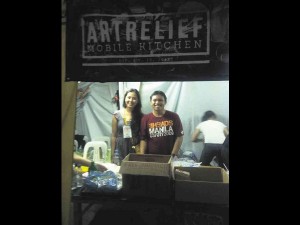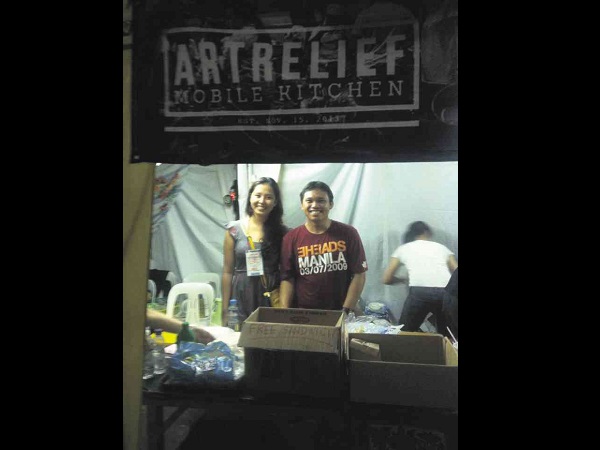
For a while, things were confusing. (Who’s in charge? Are operations moving to Camp Aguinaldo? Are our volunteer tickets still valid? How do we donate food?) But one thing remained steadfast at Operation Salubong in Villamor Air Base: the dedicated volunteers who just want to make the evacuees feel welcome and comfortable when they land in Manila.
John Ray M. Lucas and Mia Macapagal are occupational therapists who have been spending their days helping the evacuees at Villamor Air Base, volunteering at the Art Relief Mobile Kitchen booth, making sure the typhoon survivors are well-fed.
They are just two of the countless Filipinos who have been devoting their hours to volunteering at the air base, listening to the evacuees’ stories, finding them clothes to wear, helping mothers with their babies, taking care of the kids, cooking and bringing them food and bringing them to where they need to go.
We asked John and Mia about their experience at Operation Salubong, in hopes of encouraging even more people to volunteer.
Why did you decide to volunteer at Villamor?
John: I was already volunteering at the Army Gym in Fort Bonifacio prior to Villamor, doing repacking and errands. When Giselle Montero, a colleague in the NGO network, posted a status that they will be setting up a soup kitchen in Villamor Airbase, I thought of giving it a try. I am a foodie at heart so I thought this is a good opportunity to use my skills to serve the people, most especially those who are from the typhoon-stricken areas like Tacloban and Samar.
Mia: I’ve been meaning to volunteer and help out for the past few days. When I heard that they were starting operations in Villamor, I immediately grabbed that chance. Besides, there was no excuse for me not to help out since I lived nearby.
Which station were you assigned to?
J: When I first got there last Nov. 17, I was designated to make sandwiches. Since there were only a handful of volunteers, I was switching roles—from being a runner (the one who delivers food to the evacuees), to chopper (the one who prepares ingredients for cooking) and to cleaner (dishwashing and housekeeping stuff). Ma’am Giselle asked if I could oversee the operations for the graveyard shift. She suggested if we could have a more organized system of defining and delegating kitchen tasks and provide an efficient scheduling of volunteers. My colleague and fellow volunteer Mia Macapagal took care of this and was the one in charge of posting announcements via Facebook.
M: My friend invited me to help at the Art Relief Mobile Kitchen booth. We were supposed to go help in the repacking centers but the schedules for that day were already filled. I’m glad we ended up in the kitchen that day. It was the most intense sandwich making hours of my life.
What do you do at Villamor?
J: A bit of everything. I extend help whenever possible. If there is a need to lift boxes of canned goods or water or to orient volunteers or an extra hand in the kitchen, then I come to assist. But mostly, I was the one who is in charge of a particular shift (usually graveyard), coordinates and delegates tasks to volunteers, and make sure that we have adequate food supply for that shift.
M: Art Relief Mobile Kitchen feeds the evacuees, volunteers and soldiers. We provide hot meals, sandwiches and refreshing drinks to whoever needs it. I also help out by updating the Facebook page. Usually, it’s about requesting for supplies and/or coordinating with volunteers.
How often do you volunteer?
J: I go there almost every day, usually after work. I stay there for at least four hours. When its my turn to volunteer, I stay there for eight hours or even more.
M: Almost every day! It’s pretty crazy and tiring, but there’s a positive refreshing energy about the area whenever I’m there. Volunteers, from all walks of life, have one single goal of helping out.
What time do you usually volunteer?
J: I go there from eight in the evening until seven in the morning of the following day. On weekends I volunteer from afternoon until night.
M: Late evenings, around 9 p.m. onwards.
Any memorable stories you want to share?
J: Leaving from a graveyard shift, my friends and I chanced upon three men who were from Tacloban in an e-jeep ride on our way out of the base. They recounted how they waited for three days just to get into the C-130 plane, with only bottled water and biscuits to nourish them. The devastating effects of the Supertyphoon “Yolanda” has left them in shock and in pain. So we decided to get them a cab and drop them off wherever they like. Even while inside the cab, they keep narrating their struggles during and after the disaster. Despite of this, they are both thankful to be alive and that none of their immediate family members have been injured or died. It was moving when one passengers smiled and exclaimed that he was overwhelmed with the warm welcome of volunteers at the Villamor Grandstand where they were provided with counseling and free food, as if he was on a “red carpet.” One survivor left off at the Pasay Rotonda and the other in Roxas Boulevard where he would be taking a bus to Cavite City.
When we are running out of supplies, we make do of what we have. Being resourceful and innovative is the key. When we ran out of sandwich spread and all we have are sausage and cheese, we make a spread out of it. We have cooked eggs in several ways—boiled, fried, with adobo sauce, omelette, frittata etc. We also did instant pancit canton and topped it with sautéed vegetables.
I think the fact that everyone would want to help out, asking “what can I do?” or “What else do we need?” is a wonderful sight to see. The real bayanihan spirit is in full swing. You can feel the intensity and passion for service. So even when you work until the wee hours, you don’t feel tired and you just want to be out there and serve.
M: A lot come to mind, actually. But I’ll limit it to these three. One: When we ask for help, donations come sooner with so much more than expected. For example, there was a group of market vendors who had a collection drive to donate vegetables for us. There are families, from the younger ones up to the grandparents who volunteered. Private individuals who respond to the supplies requests when we need it most.
Two: The appreciative smiles we get from evacuees, other volunteers and soldiers. A cup of coffee, a sandwich and a well prepared meal really goes a long way in lifting a person’s mood.
Three: People who wouldn’t normally come together under normal circumstances are preparing meals, making jokes and surviving very stressful shifts with still a smile on their faces.
Do you have tips for people who want to volunteer at Villamor?
J: When they are on board, don’t forget to smile. For the graveyard shift, just make sure you have gotten enough sleep because there seems to have endless work to be done. We should all be happy to be doing it in the name of service.
M: Just go and volunteer. Don’t be shy if you’re alone. You’ll get to meet and befriend an amazing set of people.
Interested volunteers may check www.facebook.com/OperationSalubongVillamor for more info.









































